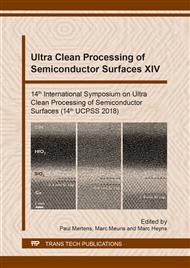p.278
p.284
p.288
p.295
p.300
p.309
p.314
p.321
p.329
Advanced Data Analysis Strategies for Understanding Particle Contamination in Chemical Distribution Systems
Abstract:
Advanced data analysis techniques can be implemented to quantitatively assess particle contamination data in state-of-the-art chemical distribution systems. Through examining the distribution of the rate of particle detection compared to Poisson’s distribution, it is possible to determine if particle variations are random or systematic and allow for the focus of improvement efforts to reduce particle levels with time. By analyzing the particle contamination data in the frequency domain via Fourier transform analyses, periodic cycles of contamination can be identified with the goal of associating contamination events with activities within the chemical delivery system.
Info:
Periodical:
Pages:
314-320
Citation:
Online since:
August 2018
Authors:
Keywords:
Price:
Сopyright:
© 2018 Trans Tech Publications Ltd. All Rights Reserved
Share:
Citation:


